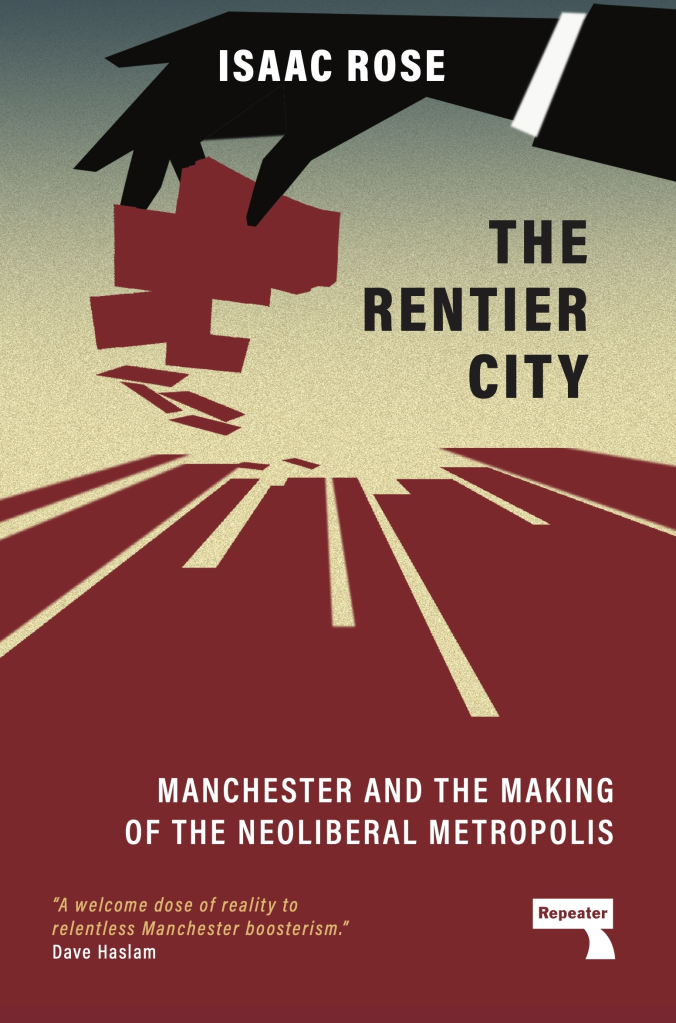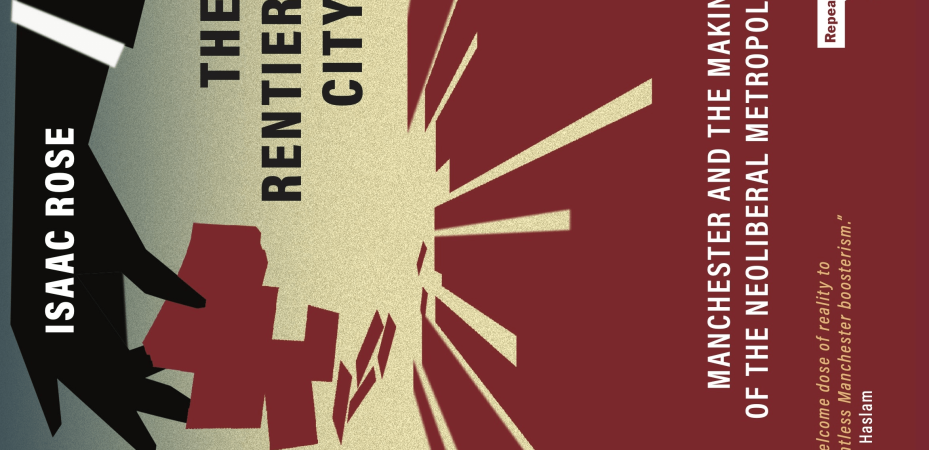Mike Phipps reviews The Rentier City: Manchester and the Making of the Neoliberal Metropolis, by Isaac Rose, published by Repeater
“Cities are battlefields,” said Walter Benjamin. This book, rich in detail, about the redevelopment of post-industrial Manchester into an unaffordable space dominated by corporate landlords, underlines this.
Rentier capitalism, it argues, plays an increasingly important role within capitalism, in the UK especially. The city of Manchester is a paradigm of this – 61% of the population rent, higher than comparable British cities, and just over half of them rent from a private landlord.
Corporate landlordism is on the rise. By the end of 2022, build-to-rent accounted for almost a quarter of a million units built or under construction in the UK. After London, whose population is 8.6 times greater, Manchester is the largest market for this kind of development.
What is lucrative for some is catastrophic for others. Rents are currently increasing at an annual rate of 20% and in some areas is far higher: “the rent burden is so high in Manchester that it outstrips London for unaffordability, due to the city’s lower wages.” These rises and a lack of available social housing are fuelling homelessness. Manchester has the highest number of households assessed as homeless in the country.
This, argues Rose, is a manufactured crisis: public subsidy has poured into private development. “Social housing targets were repeatedly unmet. Had the Council followed its own target of making 20% new builds affordable, then the city would have around 9,000 extra affordable homes by now.”
Manchester, the author suggests, is a city of two competing traditions. On the one hand is the working-class tradition of Chartism, industrial syndicalism, socialism, communism, suffragism, anti-fascism, Black radicalism and anti-imperialism. The origins of this militancy lie in the breakneck industrialisation the city underwent, from a population of 22,500 in 1773 to 400,000 in the 1840s. In 1842, the average age of death for a labourer, mechanic or family member in Manchester was just 17.
On the other hand is the history of economic liberalism, colonialism, the Anti-Corn Law League – the “party of the self-conscious bourgeoisie”, as Marx called it – and Gladstone, who owed his family’s wealth to some of the most extensive sugar plantations in Jamaica and Guyana. Rose’s history of the city, covered in the first part of the book, weaves these two strands together into a lively narrative.
By the end of World War Two, Manchester had been heavily bombed. The city’s leaders devised the hugely ambitious 1945 City of Manchester Plan, “published in a large, cloth-bound book, running to nearly 300 pages and covering every aspect of the city, from its transport infrastructure to housing, from industry to its public services and parks.” Rose hails it as “one of the most radical reimagining of a British city ever conceived… Public good was placed above private gain, rational planning above the chaos of the speculator and rentier.”
The reality turned out rather different. Tens of thousands of war-damaged and slum homes were demolished, to be replaced by overspill estates on the edge of the city. But the rate of rebuilding was slow and to make up the shortfall the Council embraced inner-city high rise blocks. Within a few years, however, tenants were up in arms: cheap materials, including the use of compressed straw left some of the flats riddled with damp and vermin-infested. Old slums had been replaced by new ones – especially in Moss Side.
Accelerating deindustrialisation precipitated the collapse of municipal vision. Between 1962 and 1972 the inner core of Manchester lost 30,000 manufacturing jobs and this decline increased over the next decades. Deindustrialisation also hit the ability of the traditional base of the Labour Party to replicate itself, particularly in strongly unionised workplaces. A new ‘urban left’, more libertarian, liberatory and grassroots, emerged to challenge the failures of top-down municipal Labourism.
This new left gained control of Manchester City Council just as the Thatcher government was moving into a decisive confrontation with local authorities over ‘ratecapping’. With the re-election of the Tories nationally in 1987 and again in 1992, the left’s worthy ambitions disintegrated into a managerial mentality inflicting service cuts and embracing urban entrepreneurialism.
Urban Development Corporations and the Tories’ Right to Buy policies bypassed local authorities, undermining their power. In Manchester, the private sector became increasingly central to the city’s development agenda. Tenants resisted the mass privatisation of estates, however, for example, rejecting the imposition of a ‘Housing Action Trust’ in Hulme. But other initiatives, such as City Challenge, saw the continued expansion of private sector influence. It marked “a gradual eclipsing of the democratic structures of the local state.”
The June 1996 IRA bombing of Manchester’s city centre destroyed more than a million square feet of retail and office space. It was seized on as an opportunity to remake the centre anew. The Manchester City Centre Management Company, renamed “CityCo” in 2000, was brought in to manage the “Business Improvement District”. It aimed to attract high-net earners, helped by the expulsion of ‘undesirables’: “By 2007 Manchester had the dubious accolade of being the ASBO capital of Britain, with 659 orders issued between 1999 and 2007, and condemned by the ombudsman for a ‘shocking abuse of power’.” Manchester MP Gerald Kaufman described the end result as “an opportunity for revolutionary urban renewal that was ultimately wasted.”
The city’s growth model resulted in stark patterns of uneven development. The financial crash hit Manchester’s property market badly and the ensuing austerity pursued by the Con-Dem Coalition government saw a tenfold increase in rough sleeping between 2010 and 2015. Resistance took the form of tent cities and a huge rise in squatting.
Meanwhile corporate asset managers moved in on the property market, producing build-to-rent properties, often taking the profit extracted offshore. “The rentierisation of the city functions as an enormous extractive machine, valorising the balance sheets of investors all over the globe,” says Rose.
This shift was enabled by the city council, through the use of public-private partnerships, the privatisation of public land, the use of financial incentives to developers and the relaxation of planning controls – together with the ruthless use of the Labour Party whip to push through the leadership’s agenda.
All of this has fuelled a major housing crisis. Leaks, mould, damp and vermin infestations remain a common problem across Moss Side, while rent racketeering spirals out of control. Homelessness is increasing, but there is now an acute shortage of social housing, because new developments include fewer social housing units than they destroy and because social housing providers are selling stock on the private market. Worsening the crisis, the rising class of private landlords find houses of multiple occupation and Airbnbs more lucrative to let.
Tenants complain that their areas are deliberately neglected, then blighted as run-down and requiring new development, which invariably displaces them. Whereas the old slum clearances were motivated by a will to build higher-quality public housing for the working class, now they are driven by private accumulation and rentier capitalism, aided by the local state.
Today, Manchester is under new leadership at council and mayoral level and there’s a stronger emphasis on social housing. But for Rose, “one thing is already clear — there will be no dramatic confrontation with the development machine.”
Yet the solutions to the crisis are obvious: “Urban land markets must be brought under democratic control. Private landlords should be squeezed out of the market by rent controls, secure tenancies and taxation, as they once were. True public housing — affordable to all at the point of need — must be our central goal.” But who might deliver this, he adds, is a question without an answer.
Readers should not be put off by the author’s mastery of detail regarding the city’s various developments in recent years. “The trends that have unfolded in Manchester over the last 40 years, as it has moved from being an industrial to post-industrial city, are not unique to it,” suggests Rose. By understanding what happened there, we can see similar patterns elsewhere and in the wider economy as a whole – and prepare to resist them.
Mike Phipps’ book Don’t Stop Thinking About Tomorrow: The Labour Party after Jeremy Corbyn (OR Books, 2022) can be ordered here.


